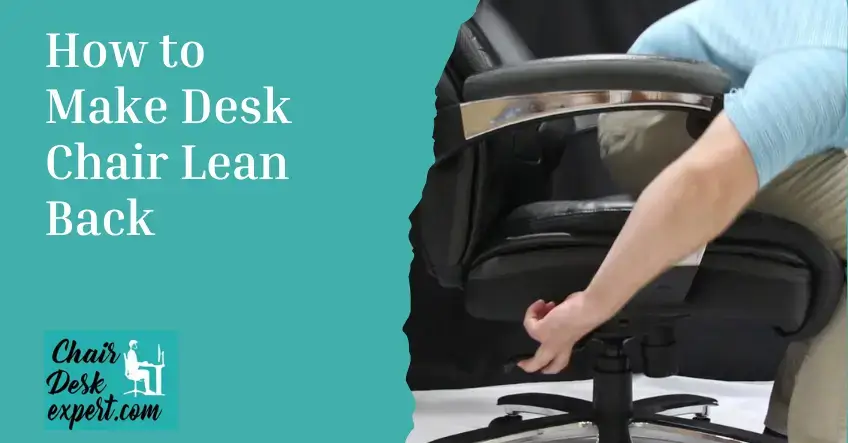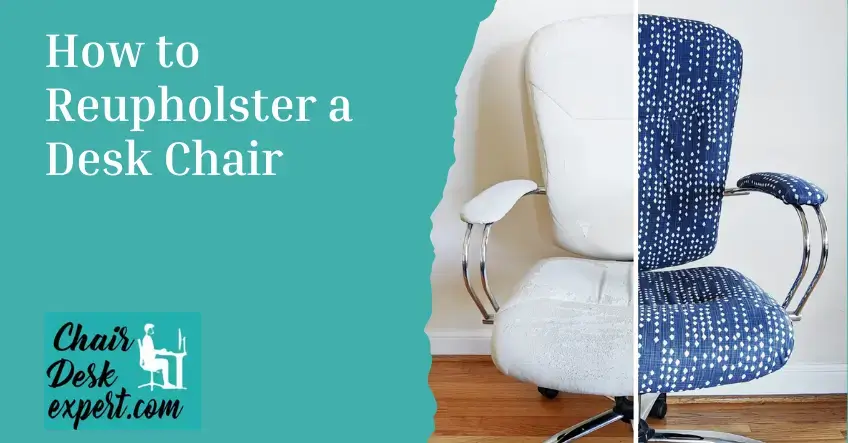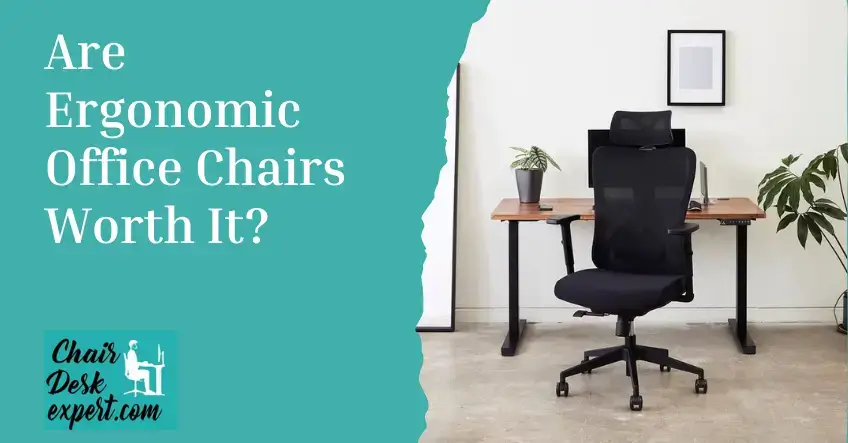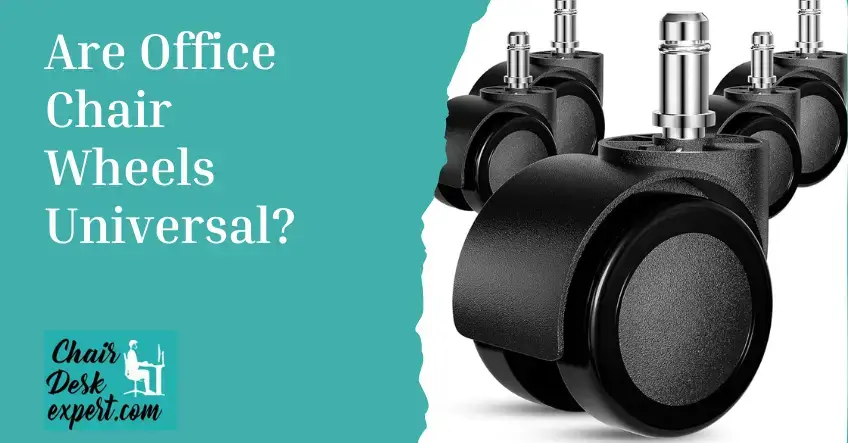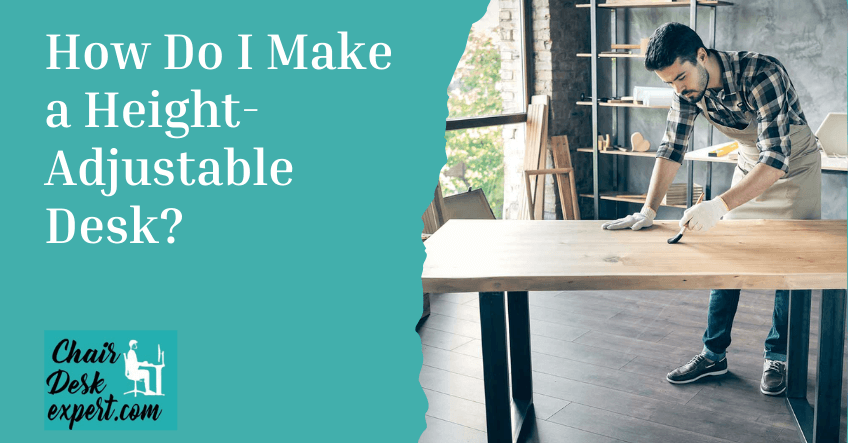If your office chair does not recline, it might need lubrication or an adjustment of the tilt mechanism on the gas cylinder.
For manual recliners, one can generally fix them by adjusting knobs and levers, but automatic ones might warrant professional assistance.
If you ask yourself why your office chair is not leaning back, you can simply test this by pushing its backrest to see whether it resists. It could indicate something is wrong with the chair’s mechanism.
High tension in the recliner or a faulty mechanism might make it hard for the chair to be reclined. Similarly, a popping sound when the backrest is being leaned backwards may indicate an impending break; hence, repair services are required. Learn How to make the desk chair lean back now!
Learn How to make desk chair lean back!
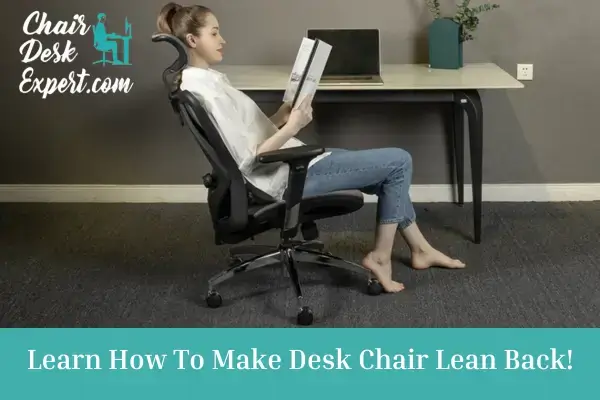
Unlocking the reclining feature of your desk chair can significantly enhance your comfort and relaxation during long hours of work or study.
Learning how to make desk chair lean back correctly is a simple process that can significantly improve your seating experience.
Identify Your Problem: Why Office Chair Will Not Lean Back
In most office chairs, a reclining mechanism consists of linear springs, radial springs, levers, and stabilizer plates. All these parts work together to control the movement of the back.
Linear springs provide enough resistance for leaning backwards. Levers and stabilizer plates assist in engaging or disengaging gears of this mechanician ship. When the tension knob is released, or the lever pulled outwards, gears are disconnected, facilitating the free forward motion of the backrest.
When pushed backwards while sitting on top of the seat’s edge so as to remove pressure from the bottom side, feet on the ground and hands rest lightly against the desk, giving maximum support for spine alignment through increased lordosis, making the pelvis tilt anteriorly.
However, there are some variations which keep the lever/knob intact irrespective of the position taken by a tilted panel behind such seats.
Thus, diagnosing and fixing an office chair that doesn’t allow tilting becomes difficult since, regardless of whether it has malfunctioned or is broken, the lever does not move.
>> Read Also: How to Make a Dorm Desk Chair More Comfortable
Common Reasons Why Did My Office Chair Stop Leaning Back?
There are various reasons for a chair to no longer lean back. Here are some common explanations:
1-Tension Knob Adjustment:
The tension knob is usually located below the chair, on its left side and manages the resistance of the reclining mechanism.
When there is too much tension, making the chair lean back may be difficult. Try turning this knob anti-clockwise to decrease tension up to an acceptable level.
2-Damaged or Worn-out Recline Lever:
If the recline lever gets damaged or wears out, it might no longer engage with the reclining mechanism appropriately.
Examine your recline lever for any signs of damage or deformation. If you notice dents or breaks in it, you will need a new one to work as expected again.
3-Faulty Recliner Spring:
A crucial part that constitutes a reclining mechanism is this piece called recliner spring, which, when defective, causes the inability of chairs to tilt backwards smoothly.
If you suspect the spring is faulty, turn it upside down and call leverage while observing the amount of pressure applied thereon; should the spring lack appropriate tensile strength, a replacement shall be necessary.
Remove the seat covering over the hole leading into the cylinder by removing screws holding the bottom portion apart from the rest structure before checking inside due to weakness such as fractures or breakages.
4-The issue with the gas cylinder
If your office chair does not lean back even after releasing the tension knob or lever, there may be a problem with the gas cylinder.
When you hear a popping sound from your chair during recline mode, this indicates that complete failure hasn’t happened yet, so spare parts may not be needed.
>> Read Also: How To Fix Desk Chair Hydraulics!
Fix Office Chair Won’t Recline
Troubleshooting and fixing this issue can be straightforward with the proper steps. Follow these tips to resolve the problem, ensuring your chair reclines smoothly for optimal comfort.
Fix it using WD-40, degreaser, and pliers:
To reverse the office chair, Flip the chair until the wheels face upwards. This can be done by putting it against the wall or another chair.
Cut off the bottom of the gas canister: You can remove a small metal clip that holds the gas cylinder in place with a pair of pliers. Office chair gas cylinders usually contain a square-shaped element.
Take out the washer:
- After removing the clip, unscrew the washer using pliers.
Dispose of star-shaped caster support:
- Detach both casters and their supports from their respective cylinders.
Take out bearings and rings:
Besides that, the topmost part of the cylinder should also have bearings as well as rings together with washers and screws, which keep them intact.
Clean cylinder:
Soak paper towel in degreaser solution and use to clean cylinder thoroughly, removing any excess oil or build-up.
Use lubricant:
Now that the clean cylinder is ready for this step, a good quantity of quality lubricant should be applied to cover the surface area completely.
Return washer, ring and bearing back to their original positions: Once those parts have been cleaned ensure they are properly greased before returning them
Then attach the caster base again: Return the caster bases to the cylinder.
Top base with a washer:
Lastly, on the star-shaped caster bases, washers should be pushed up into position.
Reattach the retaining clip at last; Screw all loose nuts and bolts tightly, especially on retainer clips, so as to hold down the gas cylinder securely.
Your office chair’s reclining mechanism will be fixed once you follow these steps, enabling you to enjoy a smooth reclining experience again.
>> Read Also: How to Fix a Sinking Desk Chair
Replace Broken or Damaged Casters
If your office chair leans backwards or sideways due to damaged/broken castors in such a situation, you will need to replace them to work well. Follow these steps in replacing castors:
Place the chair on the side:
Lay it on its sides to reveal the broken or damaged castors.
Take off broken castors: Unscrew and remove old caster wheels using a Phillips screwdriver. If the rollers do not come out quickly, you may want to use some WD-40 to free them.
Get new castors in place:
- Fit these into their sockets, ensuring they are well aligned.
Fox new-casters:
- Use a rubber hammer to gently drive each new set of casters into place without damaging any part.
Put the chair upright:
- After installing all-new casters, set it upright so it no longer tilts backwards.
>> Read Also: How to Reupholster a Desk Chair
Adjust Tilt Tension
If your office chair still leans backwards after replacing the casters, you may need to adjust the tilt tension. Follow these steps:
Sit down on the chair:
- Place your feet flat on the floor and your back against the backrest as you sit in this office seat.
Find tilt knob:
Check on the underside of the chair for the tilt knob, typically located at the bottom-left side. Consult the user’s guidebook if unsure about the location.
Set tilt tension:
While sitting down, push down the tilt knob until the seat is tilted forward. When satisfied, release the knob.
Check the tilt: lean back in the chair to try the tilt level. If it is not at your desired level, press the tilt knob again and continue adjusting until satisfied.
Fasten Your Seat Plate
If adjusting the tilt tension does not solve the problem, you may need to tighten your seat plate. This is how you do that:
Put the chair down:
- Put it down on one side so you can get to its seat plate.
Examine the seat plate:
- Have a look inside for any loose screws or marks of damage in there.
Tighten screws:
- Use a screwdriver to tighten any loose screws located on top of the seat plate. Replace any ones that are lost.
Return it upright:
Put your chair in an upright position after tightening all screws to see if it still reclines backwards. If it remains so, consider replacing a seating plate or contacting a manufacturer for further assistance.
Following these steps, you can effectively address an office chair problem that will not recline fully and ensure comfort and function while sitting.
>> Read Also: Can You Use an Accent Chair as a Desk Chair?
Tips For Maintaining An Office Chair
Office chairs, like other furniture, must be cleaned regularly and maintained well to remain practical and useful for extended periods.
They go through daily wear and tear; hence, some little upkeep every few months could increase their lifespan significantly. Here are some of the ways that can help you maintain your office chair effectively:
Observe The Casters
The casters of an office rolling chair keep rolling all through because they move on various floors, collecting dirt like hair and lint as they go along.
Flip over your rolling chair upside down to remove anything stuck inside its wheels that could have caused it to fail to move smoothly across different surfaces. Alternatively, use the suction hose from a vacuum cleaner to clean them thoroughly.
Tighten All Fasteners
There are screws and bolts used during the assembly of office chairs since they support human weight and maintain the structural integrity of the chair. E
very six months, check for any screws or bolts that are getting loose. Flip your chair to inspect the seat plate to ensure each fastener is securely tightened.
Also, fasteners under armrests should be checked and tightened to see if they exist. Always check where each fastener is located using your manual.
Protect from Sun
Suppose you have an office chair with leather or suede upholstery. In that case, shielding it from direct sunlight is important to avoid degradation.
High exposure to sunlight can cause this upholstery to fade or dry up. During peak sun hours, pull down the shades and protect the upholstery on your chairs.
>> Read Also: Can You Use a Dining Chair As a Desk Chair
Leather Chairs Need Conditioner
These types of chairs, which are designed for leather or suede offices, should be conditioned periodically in order not to dry out and also remain moistened at all times.
Apply a leather conditioner every few months so your upholstery always remains supple and hydrated too. Do not let leather get dried out by having at least 40% humidity in your office space.
By following these maintenance tips, you can have an office chair that will be comfortable for many years while being aesthetically pleasing and functionally fit.
Regular maintenance will make it last, leading to a more efficient work environment and increased productivity.
Wrapping Up
In conclusion, knowing how to make a desk chair lean back can significantly improve your comfort and productivity throughout the day.
You can achieve the optimal recline level without sacrificing support or stability by ensuring that the tilt tension adjustment is properly calibrated and balanced to your preference.
In addition, regular breaks from sitting and practicing proper posture work in tandem with the tilt feature to enhance the wellness of the spine. Considering all these will allow you to get the most out of your desk chair and create a more ergonomic and comfortable workspace.
FAQs on How to make the office chair lean back!
1-Can I recline back in my Office Chair?
Reclining back against the backrest of your workstation’s seating device may increase pressure on some areas of your spine, mainly the lumbosacral spine and neck. Vertebrae sitting with much weight forward can lead you to lean on the table or strain muscles holding you up there.
2-Why Can’t My Chair Recline Anymore?
There could be several reasons why your office chair might no longer lean back correctly. One frequent problem is that the tilt tension adjusting knob may be too tight or too loose.
This controls how much force it takes to recline the chair. If it is too tight, the chair may seem inflexible and challenging to recline, while the chair could easily fall backwards if it is too loose.
3-How do you fix an office chair that leans back too far forward?
An office chair leaning back excessively can be remedied by adjusting the tilt tension. Most office chairs have either a knob or lever under them for this reason.
When twisted clockwise, more pressure is applied to its structure, thus reducing excessive tilting backwards while seated. Therefore, adjusting the tilt tension requires finding a balance between your comfort and the functionality of your seat.
4-Why Do Office Chairs Lean Backwards?
Office chairs are made to lean back to address the discomforts of sitting upright for long periods. Holding an upright posture for long periods can put strain on one’s lower back, leading to problems like lower back pain.
The normal curvature between the spine and buttocks is maintained by allowing chairs to recline, which reduces strain on the lumbar region, thus increasing comfort associated with sitting over long periods.
5-Why Do Office Chairs Tilt?
The other reason behind having a tilting feature in office chairs is user flexibility and comfort. In some cases, certain desk chairs contain a forward tilt mechanism, whereby their front tips upwards or downwards when they are in use.
A forward tilt helps increase blood flow in your legs during sitting posture. It relieves stress from your lower spine while working from home or continuously sitting in one place for long hours.
Therefore, generally speaking, these systems aim to optimize ergonomics again, promoting proper carriage but just cosines when sitting long.

